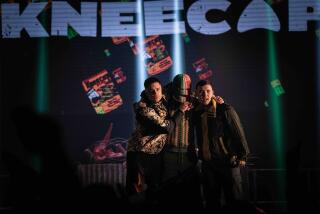Movie Reviews : ‘Rattle and Hum’ Catches U2’s Music and Message
- Share via
Rock ‘n’ roll, at its orgiastic best, was often party music exploding past its boundaries, pummeling shrieks of lust and dyonisian frenzy. But the Irish group U2, subject of the concert movie “U2 Rattle and Hum” (citywide), works a different vein. It’s starker, purer--its best songs charged with outrage against injustice.
“Rattle and Hum” records some savagely compelling live performances from U2’s 1987 tour. And it gives non-fans a chance to see why this unlikely band--four young former Dublin schoolmates, all in their mid-to-late 20s--are often ranked by critics as the world’s best.
Against music of shattering intensity and drive, they send out anthems of pacifism, interracial harmony, sweet love and romantic despair. They sing of the Irish “troubles,” of contemporary indifference, violence and greed. Lead singer Bono Hewson’s lyrics, with their cargo of fury and rapt longing, have a messianic fervor that embraces both Yeatsian poetry and black gospel music. And the look and feel of the band--a mixed Catholic-Protestant bunch--suggests a bonded community of artists clinging to friendship and ideals in the midst of chaos and war.
Most of “Rattle and Hum” is shot in lyrical monochrome with vast, tilted panoramas. We see the four musicians silhouetted against a river of fans, a human torrent twisting and swollen in the roaring canyons of the stadiums.
This black-and-white is right in the style of U2’s album photos or videos. Midway through, the film finally switches to color: an explosion of bloody reds and harsh ebony. And even though the cinematographer is Jordan Cronenweth (“Blade Runner,” “Stop Making Sense”), it’s the monochrome, shot by director-editor Phil Joanou’s USC college collaborator Robert Brinkmann, that looks more right, more memorable.
Joanou already displayed his camera virtuosity in “Three O’Clock High.” But here, though he matches the impassioned sounds with spectacular visuals, he may not be setting enough of a context. We see a bit of the quartet wandering around Dublin, Harlem, or Graceland--or engaging in a monumentally failed interview. Joanou asks banal questions; the band smirks. Mostly, we get only teases.
Singer Bono (Hewson) seems dourly, fiercely charismatic. Lead guitarist Dave (The Edge) Evans is a wry wisp spouting blues licks. Bassist Adam Clayton looks like a street-gang’s bespectacled pet intellectual. Blond-cropped drummer Larry Mullen Jr., the best camera subject, is sprightly and swift, an elfin jock. (Though U2 is a notoriously humorless onstage group, Mullen supplies some bright backstage moments.)
Yet, if Joanou muffles the context, the music comes through searingly clear. There’s the fervid, screaming despair of the anti-war “Sunday Bloody Sunday” (an unusual display of courage for a Dublin-based band); the hushed prayer of the Martin Luther King elegy “Pride (In the Name of Love).” And the scorching attack on contemporary American belligerence, “Bullet the Blue Sky,” which contains biblical imagery of locusts and plague, the “rattle and hum” of the film’s title.
The movie’s two musical high points are the group’s “Joshua Tree” hit, “I Still Haven’t Found What I’m Looking For,” sung in a Harlem church, with spine-chilling accompaniment by the local choir, and a later duet with B. B. King on “When Love Comes to Town,” a song written for him.
These ballads, poignant meeting grounds, briefly confirm those cultural or psychic similarities John Ford saw between the Irish and the American blacks: a common pain and persecution, a common unity, a common strength. And in U2’s hands, a common song. Black as rage, white as faith, soft as hope and sharp as pain, it’s a song that surges out, stabs you with its eloquence and fire. “Rattle and Hum” (MPAA rated PG-13 for language) preserves it beautifully.
More to Read
Only good movies
Get the Indie Focus newsletter, Mark Olsen's weekly guide to the world of cinema.
You may occasionally receive promotional content from the Los Angeles Times.










